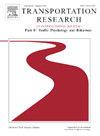Charging or Swapping? A study on the private Consumers’ acceptance of the electricity replenishment mode of new energy vehicles
IF 3.5
2区 工程技术
Q1 PSYCHOLOGY, APPLIED
Transportation Research Part F-Traffic Psychology and Behaviour
Pub Date : 2024-10-28
DOI:10.1016/j.trf.2024.10.015
引用次数: 0
Abstract
In recent years, two types of electricity replenishment modes of new energy vehicles (NEVs) have gradually developed in the NEVs market, one is the battery charging mode, and the other is the battery swapping mode. These two electricity replenishment modes have their own advantages and disadvantages, and consumers have different usage experiences. Generally speaking, the battery charging mode is usually more economical than the battery swapping mode, and its usage scenarios are more common, but in terms of replenishment speed and convenience, the battery swapping mode has obvious advantages. Based on the unified theory of acceptance and use of technology (UTAUT) model, this paper tries to explore the key impact factors on the private consumers’ acceptance of the electricity replenishment mode of NEVs in the market, investigate the heterogeneity of gender, age, and income, and justify the development trend of the electricity replenishment mode of NEVs, aiming to provide managerial insights and policy implications for the high-quality development of the electricity replenishment mode of NEVs. The results indicate that among the five-dimensional variables we selected, performance expectancy has little effect on acceptance, while effort expectancy, social influence, and quality sensitivity have a positive impact on acceptance, and perceived risk has a negative impact on acceptance. Gender, age, and income level had different effects on each variable. This has a reference enlightenment for the follow-up production and marketing of related enterprises.
充电还是换电?私人消费者对新能源汽车电力补充模式的接受度研究
近年来,新能源汽车市场逐渐形成了两种电能补充模式,一种是电池充电模式,另一种是电池交换模式。这两种电力补充模式各有利弊,消费者的使用体验也不尽相同。一般来说,电池充电模式通常比电池更换模式更经济,使用场景也更普遍,但在补电速度和便利性方面,电池更换模式具有明显优势。本文基于技术接受与使用统一理论(UTAUT)模型,试图探讨私人消费者对市场上新能源汽车电能补充模式接受度的关键影响因素,研究性别、年龄和收入的异质性,并对新能源汽车电能补充模式的发展趋势进行论证,旨在为新能源汽车电能补充模式的高质量发展提供管理启示和政策借鉴。结果表明,在我们选取的五个维度变量中,绩效期望对接受度影响不大,而努力期望、社会影响和质量敏感性对接受度有正向影响,感知风险对接受度有负向影响。性别、年龄和收入水平对各变量的影响不同。这对相关企业的后续生产和营销具有参考启示意义。
本文章由计算机程序翻译,如有差异,请以英文原文为准。
求助全文
约1分钟内获得全文
求助全文
来源期刊
CiteScore
7.60
自引率
14.60%
发文量
239
审稿时长
71 days
期刊介绍:
Transportation Research Part F: Traffic Psychology and Behaviour focuses on the behavioural and psychological aspects of traffic and transport. The aim of the journal is to enhance theory development, improve the quality of empirical studies and to stimulate the application of research findings in practice. TRF provides a focus and a means of communication for the considerable amount of research activities that are now being carried out in this field. The journal provides a forum for transportation researchers, psychologists, ergonomists, engineers and policy-makers with an interest in traffic and transport psychology.

 求助内容:
求助内容: 应助结果提醒方式:
应助结果提醒方式:


